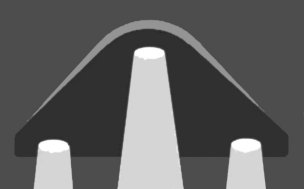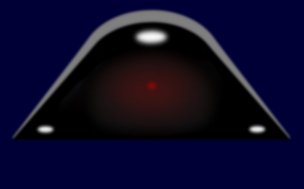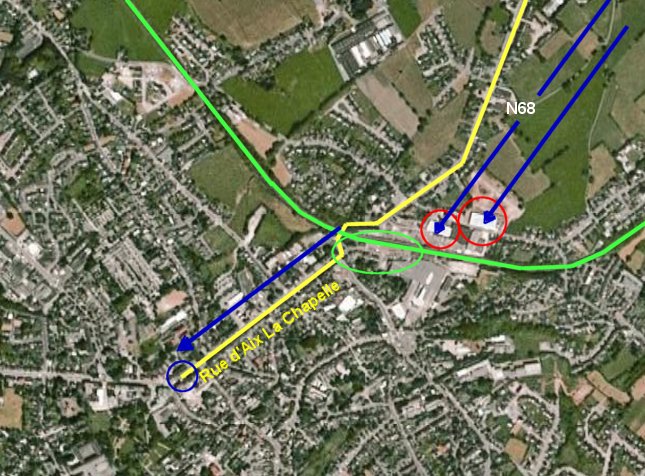The hour of the observation was determined by various checking by the investigator, scientist Auguste Meessen, as being towards 05:30 p.m..
M.D. [or Mr.D.], watchman at a company located at the entry of the town of Eupen on the East side of national road N68 close to the station is on the higher floor of the building opposite a very broad window directed towards Kettenis.
He sees a white light, “extraordinarily intense”, a little above the horizon and wonders whether it is a star or a plane.
After a while, he looks at it again and notes that the light approaches very slowly straight towards the building where he stands, and that it comes from a direction between Eynatten and Raeren; which puts it East of national road N68.
He wants to check whether it emits the characteristic noise of a helicopter and opens the window to this end, and does not hear any engine noise.
As the object approaches, he distinguishes that it has a flat bottom which carries three large circular headlights laid out in triangle.
Just before the object passes above the roof of the building where he stands, at its vertical, he clearly sees that the front point of the object is rounded, and that it is a platform which widens like a parabola.
The edge of the object has a relatively low height compared to its width, and has clear parts as if it carried a reflective metal coil.
He sees that between the three white headlights, in the center, there is a small red light which flickers. He would say that the frequency of this flickering was a little slower than the blue rotating light of the ambulances, that is, approximately twice a second.
This red light allows him to see that the lower surface of the object is flat.
When the object was at his vertical, he managed to hear a gentle noise which was like a noise of wind, “wffff”.
The object passed above the roof and the witness immediately ran to the other side of the building, where he did not see the object anymore. He then opened the window and managed to see that the object had made a turn towards the right, he sees it still just before it gets hidden by the corner his building.
He observes that the object must have descended because it is at the level of his eyes.
The investigator notes that the object probably crossed the national road N68 above the railroad bridge which spans it, and that it then probably skirted the street of Aachen while going down towards the town hall which is on the right side of this street, because the next sighting seems to be the continuation of this one.
The witness estimated that the object's speed was between 60 and 70 km/h and that it was less than 200 meters above.
The witness was very impressed by the width of the lower surface of the object and told investigator Auguste Meessen that it was something powerful and massive, he used the German term “wuchtig”.
A black and white sketch illustrates the report; it is not specified whether it was approved or not by the witness. The sketch shows the object like this:

|
Sources:
A secondary source says:
1989, 29 November
BELGIUM, Eupen
Towards 17:30 watchman M. D. of a company at the entry of Eupen close to N 68, is on the floor of the building and sees by the window a little above the horizon, in direction of Kettenis, an extraordinarily intense white light. After a few moments he looks again and sees that this light approaches in straight line towards the building. He opens the window, but does not hear any engine noise. Progressively with the approach of the object he distinguishes a flat lower surface, carrying three large circular headlights laid out in triangle. Just before the object passes above the building, he sees that the front point is round. It is a platform which widens like a parabola. The edge has a relatively low height compared to the width of the object, with clear parts, as if it were a reflective metal coil. In the center of the triangle marked by the headlights directed downwards, a small red light flickers approximately 2 times a second. The speed of the object is 60 to 70 km/h and the altitude approximately of 200 meters. He hears a soft noise but only when the object is very close to him, as a weak noise of wind “wfff”. The object veers on the right and ends up disappearing. (VOB 1 - SOBEPS 1991, p. 20, 21)
Source:
Another report, in the Flying Saucer Review, indicated for this observation:
Roughly at about 1800 hrs, Monsieur Jean-Marie Demoulin saw three circular white lights moving from Ketennis towards the railway station at eupen. At the front there was what looked like a thin rounded rim. Estimated speed: 60 or 70 km.p.h. Monsieur Demoulin opened a window and listened as the object passed above his house, and he heard something like “a slight noise of wind”. Over the railway bridge the thing changed course, and headed off towards the Eupen town hall.
Source:
The sketch in [vob1] shows the object like this:

|
I note that the report does not state that the witness saw the cut corners at back of the object, nor that the headlights projected vertical and delimited beams of light, and that the red central light reported by the witness is missing since hidden by the front beam. The elements of difference between the story by the witness can be justified by declarations of the witness not included in the report, but can also be simply fictitious, coming from the fact what these details are reported in other sighting reports of this evening in the same area.
I tried to show the object only according to the description by the witness in [vob1]:

|
It is an almost impossible exercise. The indications of the report are for examples clear on the fact that there are three circular headlights laid out in triangle at the bottom surface of the object. But white or yellow or another color? With delimited light beams, halation, or no projection? Of which sizes relative to the size of surface? At each corner, or in triangle but gathered close to the center? The red light is described better. Central, red, flickering every 2 seconds, projecting a halation letting see the lower surface of the object. The edge is described as not very thick relative to the surface and evoking a reflective stripe. But of metallic or phosphorescent type? The witness talks about clear parts, which suggests that it is not the whole edge which presented this aspect of reflective stripe. The front contour is described: the point at the front of object is round, but also, it is a platform which widens like a parabola. The triangle widens then perhaps well more, backwards.
With regard to the color of the sky: I give the theoretical color in this place on this date and hour; the sun set at 04:45 p.m., however in urban area the luminous pollution of public lightings, if there is any, can produce a clearer sky of a different color. One thing is that there is no reason to believe that the contour of the object could not have been distinguished from the background of the sky.
An important matter is that of the size. The report gives neither absolute size neither relative size nor angular size. Only indications on its altitude above the ground are given: less than 200 meters, and, at the end of the observation, yes level, from the unspecified floor of a building of perhaps several floors; which is something would be probably below the 200 meters when it was at eyes level, perhaps between the 20 and the 50 meters.
An angular size could have been given by studying the passage of the machine above the building's roof. The left and right ends of the object could have been located by taking the matching spots of the building as reference mark. Perhaps that was done but since the investigation report, if one was written, is not available to me, I do not know.

|
The witness is located: “at the entry of the town of Eupen on the East side of the national road N68 close to the station”, “on the higher floor of the building opposite a very broad window directed towards Kettenis.”
The zone of the station is in the green ellipse, above, the yellow line is the layout of N68. The witness is most probably in one of the two white buildings which I circled in red, they face the direction of Kettenis. The witness sees the object arriving from a direction between Eynatten and Raeren thus indeed at the East of N68 as he says. Roughly the trajectory of the object is thus at this step of the sighting one of the two blue arrows of the right, one or the other depending which building he was in.
When the object passes above its building, it passes on other side of this building and initially he does not see it anymore, he had to open the window to find it. This suggests that it has to put his head out of the window to see it again on his right hand side. He deduces with reason that the object had to veer, above the building, it did not continue its expected straight line trajectory above the building. (Of course one could speculate that the object “vanished” and that another object was spotted then, since there is a discontinuity in the observation.)
The object “hidden by the angle of his building”. I think it is possible that “his” building is that at the left (on the map) which masks the object one moment and that he is in the building on the right.. The two buildings could belong to the same company, and he thus might have said “his” building.
It is at this time that he notes that the object must have descended because it is now at his eyes' level.
The investigator notes that the object probably crossed the national road N68 above the railroad bridge which spans it (Intersection of the yellow line of the N68 and the green line which is the railroad), and that it then probably skirted the street of Aachen while going towards the town hall which is on the right side of this street, because the next sighting seems to be the continuation of this one. If such is well the case the trajectory of the object is thus that of the blue line on the left of the map, skirting the street of Aachen towards the town hall in the blue circle, and the following observation could then be the one in the Rue Pavée.
Among the preceding observations along N68, we have the customs house close to Lichtenbusch sighting.
I browsed the literature and the remarks from “skeptics” about the Belgian flap to find possible ordinary explanations or proposal for ordinary explanation of this sighting. I found none.
On the other hand, “general” explanations abound. According to the one or the others, the Belgian flap is explained entirely as caused by helicopters, airliners, ultra-light planes, secret planes, remote-controlled balloon, balloons, hoaxes, “psychic phenomena”, etc, and one can thus think that the authors opposed to the notion of extraterrestrial visitors see this case explained a priori by one or the other of these causes.
A few things then need to be said.
First of all, Wilfried de Brouwer, then responsible for the military sky survey in Belgium, clearly stated that for that night in the area of Eupen, checking were made with the recorded data of the primary Belgian military radar set stations, in order to know whether these observations were planes or helicopters or any other aircraft, whether Belgian or foreign, and none of cases around Eupen proved to be caused by aircraft. “Skeptical” authors are unaware of this generally, or at least, say no word about this.
This simple fact however eliminates the explanations by terrestrial aircraft. But let us imagine one moment that the Belgian military did not know how to do their job properly.
The fact of the absence of noise in such observations is sometimes simply ignored, or sometimes allotted to magical “temperature inversions”, unfavorable winds, witnesses in closed vehicles or closed building, helicopters that are allegedly “silent”, planes that “more distant than reported”, or lapse of memory of the investigator to note whether there was or was not engine noise.
None of such explanation fits in this case.
It should well be understood that we would have a plane or helicopter at very low altitude above town, and that nobody among the witnesses of more than one hundred sightings reports, and nobody else, reported a passage of a plane or helicopter at low altitude on the city! We are supposed to believe that the totality of the awaken people in Eupen that evening became “UFO crazy” - though UFOs were not at all a current topic then, we are at the first important day of the flap - a UFO craze that would have made people deaf, or under magical “temperature inversions”, and that none among the people who “saw it” nor among the rest of the population of Eupen, would have been able to recognize a plane or a helicopter.
The thing reported here comes from the distance, an obviously unknown initial distance, but it passes above the roof of the building where the witness stood, to be seen again on other side, and this time at eyes level. It is clearly at very low altitude. this is not a plane or helicopter so distant that it was inaudible, wind or temperature inversions cannot magically explain the lack of engine noise as weather data indicate no strong wind, and no temperature inversion capable of silencing such a close plane or close helicopter noise.
The witness is not inside a vehicle, and whether the object was silent or not is clearly reported: the witness thinks initially that it could be a plane, or helicopter. He wants to check whether it emits the characteristic noise of a helicopter and opens the window to this end, and he does not hear any engine noise. When the object was at his vertical, it managed to hear a soft noise which was like a noise of wind, “wffff”.
Clearly this has nothing to do with the sound of a plane or helicopter passing above a building. Worse, some sound was indeed heard, thus it was not be masked by some intense road traffic or other general noise, but it was obviously neither the loud rotor sound nor the howl of jet engines, not even the combustion engine of a private plane or ultralight plane. There is no omission, the sound question is documented. I is clearly stated that the witness, seeing the light come from the distance, immediately thought about planes and helicopters, not that it was “a UFO a priori”, and clearly and wisely made the check on this matter.
An airship, a balloon then? Alas, 20 years after the sighting, I still wait to see the least realization of such a balloon type or flat triangular airship type with a red light in the center and three white fires at the corners in Belgium at that time. But also, these craft would be motorized too, they would do not move by magic through the countryside and city silently with a slight sound of wind.
A frequent comment by proponents of the psycho-sociological explanation for UFO sighting report when reports mention lights laid out in triangle is that when people see three lights, they are prompt to imagine a supporting object even when there is none. This does happen. A “shape” is sometimes just a personal interpretation by witnesses, the do see it and do not claim to see it, they just “reason”, often falsely, that lights in close formation “should” be attached to something, even if this something is not visible. However, in this case for example, the witness does not only see “lights”, but he see an outline, he sees a shape rather than making it up from scratch because he reports the brightness of the front edge of the triangular shape. If this important feature is just “imagination”, why not call every UFO sighting report and each and every feature of any UFO sighting report “imagination”?
Lastly, the current fashion is with “esoteric UFO” and other “spirit of Gaia UFO illusions” and “psychic phenomena”, the fashion is to take no notice of UFOs missing supernatural, UFOs that are too “nuts-and-bolts”. Here, we have a sighting report with nothing of the “parapsychological magic” that one finds abundantly in stories of the so-called “contactees” and others false prophets; so it is not surprising that this type of sighting, deprived of “poltergeists”, “Virgin Mary”, “Oz factor” and other “witness who became a psychic healer after his sighting”, so it is hardly mentioned in the literature of the supernatural buffs.
| Version: | Créé/changé par: | Date: | Description: |
|---|---|---|---|
| 0.1 | Patrick Gross | October 4, 2009 | Creation. |
| 1.0 | Patrick Gross | October 4, 2009 | First published. |
| 1.1 | Patrick Gross | September 18, 2013 | Addition of the information in FSR, [fsr1]. |